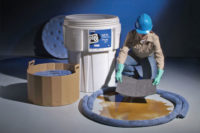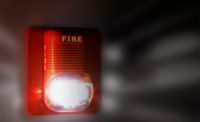Employees have been evacuated from the spill area. The onsite response team is suiting up and reviewing their plan to contain the spill and keep it from reaching a nearby creek.
Now is not the time to start frantically paging through a dust-covered spill response plan — or worse, an outdated phone book — to try to find a store in the area that might have a piece of equipment that the responders will need. It’s also not the best time to meet the county hazmat response team for the first time.
Most facility spill response plans contain a list of contact names and phone numbers for fire departments, hospitals, police, equipment suppliers and other resources that may be needed during or after an incident. However, this list is often overlooked when plans are reviewed and can quickly become outdated.
On the other hand, maybe that list is up-to-date, but it doesn’t include information for response equipment that’s readily available in the community because no one at the site knows about it.
Reviewing contact lists
A facility’s list of resources needs to be kept up-to-date if it is to be of any value during an emergency. This isn’t always an easy task, but it will pay off the first time it needs to be used.
Responding to a spill or any other emergency is stressful enough. Watching a retention pond quickly fill up and finding out that the only phone number listed in the plan for a vacuum truck is no longer in service won’t make the day go any better. Finding out that a vacuum truck is available, but that the store closes in five minutes won’t help drain that pond quickly either.
Routinely maintaining and updating contact information for suppliers and documenting information such as account numbers, terms, store hours and product availability makes this list valuable and will help responders more accurately gauge what is likely to be available after an incident.
When talking with equipment or service suppliers, ask them about their ability to supply items even if there is a widespread disaster in the community. If they cannot guarantee 24-hour availability, note any limitations in the plan and consider having an additional supplier or two listed as backups.
Like equipment suppliers, contact information for emergency services can also change. Contact lists in response plans should always be more extensive than a single listing of “9-1-1”as the emergency response number. Even if local emergency resources are all dispatched from the 9-1-1 center, at a minimum, plans should contain contact names and phone numbers for the local fire department, police department, hospitals, ambulance service, transportation services, the local emergency management coordinator and the emergency management director.
Listing the phone numbers for state environmental protection agencies, as well as the National Response Center, can also help to facilitate any mandatory calls to those agencies in the event of a reportable spill.
Meet first responders
In addition to having an accurate list of names for local emergency resources listed in a response plan, make the time now to meet each of these people before an actual emergency.
Establishing a working relationship with each of the outside emergency resource personnel listed in a facility response plan helps onsite responders develop a higher level of comfort when it becomes necessary for them to work together during an emergency. Most local fire departments and hazmat teams welcome the opportunity to tour facilities and meet onsite response personnel.
These relationships expand the capabilities of both the onsite responders and the external first responders to handle large emergencies safely. Onsite responders benefit from the experience of others who share their training and skills; external responders benefit from gaining familiarity with the site’s layout, processes and any specific hazards that may be present.
Establish mutual aid agreements
A good working relationship with local first responders can help facility coordinators become more aware of large response equipment that may be available to them through mutual aid agreements. Items such as containment booms, mass decontamination lines and vacuum trucks are among the equipment that is often available to responders in many communities.
Additionally, neighboring facilities can work together to share the cost of a spill response trailer or other expensive response items that both facilities would need for a response but may not have the budget to purchase on their own.
Know the limits
When mutual aid agreements or shared equipment is part of the facility response plan, document how long it is going to take for that equipment to get to the facility. If it will take an hour for a piece of equipment to arrive, response plans need to reflect this and describe what actions can or will be taken in the interim.
Local bus companies are commonly listed when facilities need to evacuate a large number of people from an area surrounding an incident. Too often, the bus company is not aware that they are named in a facility plan, and they may not have extra busses, drivers or the capability of supporting a large-scale evacuation.
Like equipment, arrangements for bus companies, warming or cooling shelters, hospitals, food and other services should be established in advance so that expectations can be better managed during an incident.
Host drills
Routine drills help responders become comfortable with the tasks that they will need to perform during an actual emergency. Drills can also help uncover the need to amend or expand current plans.
Consider inviting local first responders to drill with onsite team members. Responders who are given the opportunity to drill together are better able to develop a level of trust for each other and will be more comfortable working together during an actual emergency. Outside responders can also be a fresh resource for suggesting plan revisions that may enhance the safety or efficiency of an onsite response.
Becoming a member of the city or county’s Local Emergency Planning Committee (LEPC) is another way to keep in touch with community first responders and stay informed about local and regional response capabilities. It is also a good way to learn about new response techniques and equipment that others in the community are using to increase safety and minimize the impact of a spill.
Establishing relationships with local responders and taking a little bit of time each year to properly maintain an accurate contact list will help ensure that resources are available when they are needed and onsite responders are not scrambling for the tools, equipment, services or additional help that they need.
Look for this article in the March issue of ISHN. |






